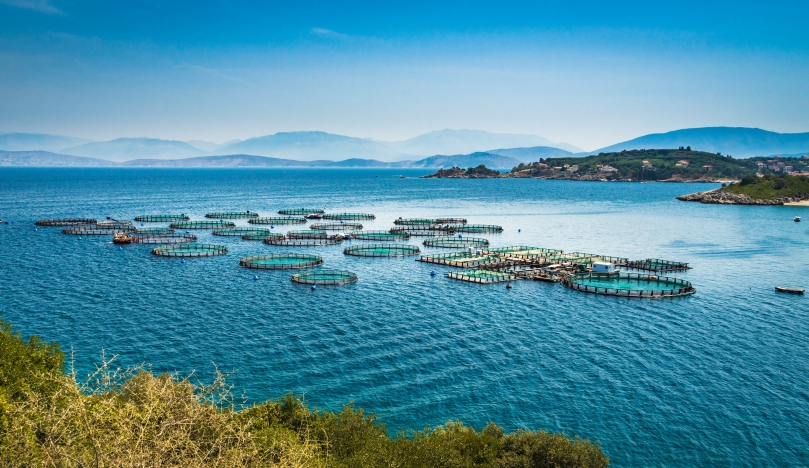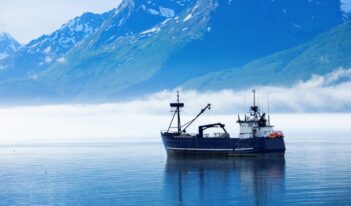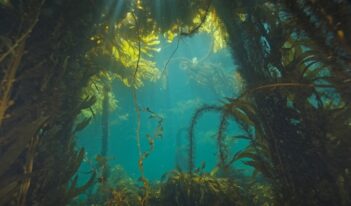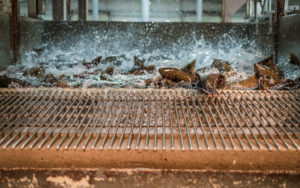
A CRS report finds that offshore aquaculture can spur economic growth if permitting reform takes place.
The world is getting hungrier for fish. Fish consumption has outpaced population growth, but the volume of ocean fishing has remained relatively flat for three decades. Fish farming—or aquaculture—has made up the difference, with production more than doubling between 1997 and 2019. Today, aquaculture provides about half of the world’s seafood.
This growth is not the trend in the United States, which relies instead on imports for more than 80 percent of the seafood its population consumes. According to a report by the Congressional Research Service (CRS), aquaculture production could increase dramatically in the United States. But to do so, Congress will need to reform the nation’s ocean permitting system, the CRS concludes.
In addition, Congress has failed to authorize any single federal agency to permit offshore aquaculture facilities. Agencies ranging from the U.S. Army Corps of Engineers, the National Marine Fisheries Service (NMFS), and the U.S. Environmental Protection Agency each regulate portions of the aquaculture permitting process. The Magnuson Stevens Fishery Conservation and Management Act (MSA) regulates offshore fishing generally, but not offshore aquaculture facilities specifically. Still, NMFS has claimed sole offshore aquaculture management authority under the MSA based on the act’s use of the term “fishery.”
Case law added more uncertainty to the offshore aquaculture industry’s future in 2018, when a federal court invalidated NMFS’s interpretation of the MSA in Gulf Fisherman’s Association v. National Marine Fisheries Service. The court held that NMFS “exceeded its authority” under the MSA by trying to regulate aquaculture in the Gulf of Mexico. As the CRS notes, leaving regulatory authority over offshore aquaculture to regional councils instead of a federal agency could allow these regional councils to impose conflicting or contradictory permitting requirements.
As the CRS notes, offshore aquaculture bills were introduced in Congress five times since 2005, but none were enacted. The Advancing the Quality and Understanding of American Aquaculture Act (AQUAA), re-introduced in 2020, would have directed the National Oceanic and Atmospheric Administration to “coordinate regulatory, scientific, outreach, and international issues related to aquaculture.” But Congress never voted on AQUAA, so potential offshore aquaculture developers must deal with a tangle of regulations set by at least six different federal agencies.
The CRS also discusses the red tape that federal environmental requirements impose on the offshore aquaculture permitting process. The National Environmental Policy Act, for example, requires federal agencies to consider the environmental impact of proposed offshore aquaculture facilities. NMFS must also review project proposals, such as those of offshore aquaculture facilities, that can “affect marine mammals or threatened and endangered species.”
Offshore aquaculture’s opponents emphasize the importance of federal environmental protection and argue that unused feed and fish waste can degrade both the quality of surrounding waters and the sea floor beneath the offshore fishery’s nets. High fish densities and poor water circulation can also cause eutrophication—nutrient concentrations reaching toxic levels in water. Proponents of offshore aquaculture counter that open ocean waters are more likely to dissipate fish waste than calmer coastal waters.
Opponents of offshore aquaculture also point out that aquaculture in the United States has struggled to compete with higher quality, cheaper imports from Norway, Chile, and Canada. These opponents contend that foreign aquaculture producers are more competitive than U.S. producers because they are subjected to less restrictive environmental or labor regulations than domestic producers. But the CRS shows that trade protections, such as tariffs and quotas, could enable the offshore aquaculture industry to compete with foreign producers.
Fishers also oppose offshore aquaculture because they perceive it as a threat to their livelihood. The CRS finds, however, that investment in offshore aquaculture could also benefit the traditional fishing industry. Not only could a robust offshore aquaculture industry revive economically depressed coastal areas, but it could also encourage investment in the same docks, cold storage, and processing facilities on which fishers rely.
The CRS maintains that a regulatory framework for offshore aquaculture should give statutory and leasing authority to a single federal agency while coordinating with other federal agencies throughout the permitting process. Such a framework could hasten the permitting process and promote greater transparency and stakeholder input.
Otherwise, the CRS concludes that offshore aquaculture development in the United States looks unlikely.



